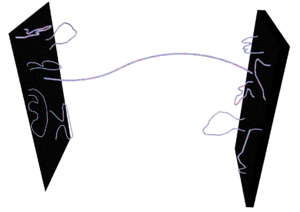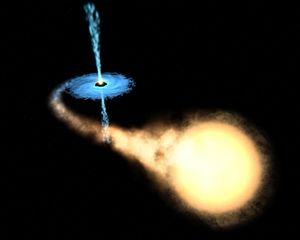String theory facts for kids

String theory is a big idea in physics that suggests everything in the universe is made of tiny, vibrating strings. Imagine these strings like super-small, one-dimensional rubber bands!
This theory tries to explain how absolutely everything is connected. It's a way to bring together two very important but different ideas in physics: quantum physics and general relativity.
Contents
String Theory: Connecting the Universe's Secrets
Scientists have two main rulebooks for how the universe works. But these rulebooks don't quite fit together. String theory tries to be the bridge between them.
Quantum Physics: The World of the Super Small
Quantum physics is all about super-tiny things. This includes electrons, atoms, and even smaller particles inside them. It describes how these tiny particles behave in strange and wonderful ways.
General Relativity: Understanding the Big Picture
General relativity is about the universe on a grand scale. It explains how huge objects like planets and galaxies move. It also shows how gravity works, even bending space and time.
The problem is, these two theories work great on their own. But they don't agree when you try to use them together. This is especially true in extreme places like inside a black hole or at the very beginning of the universe. Scientists hope that a theory of quantum gravity could combine them. Many think string theory (sometimes called the Theory of Everything) might be the answer!
Where Are These Tiny Strings?
To understand string theory, let's think about how small things can get.
From Tables to Quarks: Getting Super Tiny
Imagine you have a table. You can cut it into smaller pieces. Then you can grind it into a fine powder. If you look at that powder under a microscope, you'd see tiny particles.
But things get even, even smaller inside those particles! First, you'd find molecules, then atoms. Inside atoms, there are electrons spinning around a central nucleus. The nucleus itself is made of protons and neutrons. And guess what? Inside protons and neutrons, there are even smaller particles called quarks!

String theory suggests that inside these incredibly tiny, dot-like particles (like quarks and electrons), there are actually little vibrating strings of energy.
How Vibrating Strings Make Everything
Think of a guitar string. When you pluck it, it vibrates and makes a certain note. If you press down on the string and pluck it again, it vibrates differently. This makes a different note.
Scientists believe these fundamental strings in the universe work in a similar way. Instead of making musical notes, their different vibrations create different particles! If a string vibrates at one specific frequency, it might create a quark. If it vibrates slightly differently, it could create an electron or a photon (a particle of light). So, all the different particles in the universe might just be different "notes" played by these tiny strings!
The Universe's Four Forces and Strings

Our universe is governed by four fundamental forces:
- The electromagnetic force (which creates light, electricity, and magnetism).
- The strong nuclear force (which holds atomic nuclei together).
- The weak nuclear force (involved in radioactive decay).
- Gravity (which pulls things together).
String theory tries to tie all these forces together. Scientists believe that the strings associated with these four different forces can interact with each other. This shows how they are all part of one big system.
Beyond Strings: What are Branes?
As scientists explored string theory, they realized that the theory also needed other objects besides just strings. Imagine a big, flat sheet, and some strings are attached to its ends. Scientists call these sheets branes (short for "membranes"). These branes can be flat or curved. They can also have different numbers of dimensions.
Our World: More Than Just Three Dimensions?
This is where string theory gets really mind-bending! It only makes sense if our world is made up of more than just the three dimensions we usually experience.
Our everyday world has three dimensions:
- Front and back (like walking forward or backward).
- Left and right (like turning left or right).
- Up and down (like jumping up or down).
Scientists propose that we might actually be living on a 3-dimensional sheet or brane within a larger space. It's possible that there are other dimensions attached to this brane that we can't see directly! In fact, string theory suggests there could be as many as six or seven extra dimensions. They might be curled up so tiny that we don't notice them. Some scientists even wonder if black holes could be a way we could travel to these other dimensions!

Supersymmetry: Particle Partners
One of the main concepts in string theory is called supersymmetry.
According to string theory, every particle in the universe can be divided into two main groups:
- A boson (which is a force particle, like a photon that carries light).
- A fermion (which is a matter particle, like an electron that makes up atoms).
In supersymmetry, the idea is that if you have a boson, there must be a fermion partner for it somewhere in the universe. And if you have a fermion, there has to be a boson particle partner for it. Scientists are actively looking for these "superpartners" in experiments like the Large Hadron Collider.
Scientists are still working hard to find out if string theory will truly solve the puzzle of how quantum physics and general relativity fit together. They want to know if it's the ultimate "Theory of Everything." It's a fascinating area of ongoing research!
See also
 In Spanish: Teoría de cuerdas para niños
In Spanish: Teoría de cuerdas para niños

